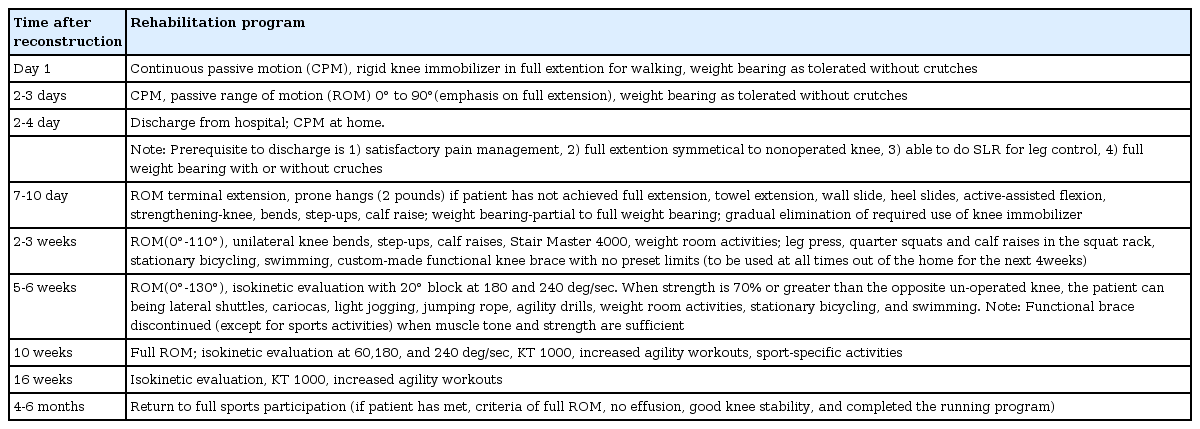Exercise Rehabilitation after Anterior Cruciate Ligament Reconstruction
Article information
Abstract
OBJECTIVES
Exercise rehabilitation after anterior cruciate ligament (ACL) reconstruction has changed dramatically in recent years. In this review, we discuss recent changes in exercise programs related to ACL rehabilitation.
METHODS
We conducted a literature review of recently published articles related exercise programs after ACL reconstruction.
RESULTS
The accelerated rehabilitation program, which allows patients to achieve full extension ofthe knee early in the postoperative period, is now a widely practiced rehabilitation program. A prospective study of rehabilitation programs after ACL reconstruction showed that early joint exercises do not interfere with the healing of grafts. Instead, they alleviate pain, thereby reducing the negative impact. Moreover, according to several biomechanical studies, open kinetic chain exercises are potentially disadvantageous to knee stability. There is no evidence that early weight bearing results in weakening of graft distraction or internal fixation compared with delayed weight bearing.
CONCLUSIONS
In conclusion, prevention of ACL injuries and rehabilitative exercise training can help to achieve optimal exercise performance while avoiding the risk of sports-related injury.
INTRODUCTION
Exercise rehabilitation after anterior cruciate ligament (ACL) reconstruction has changed dramatically in recent years. Previous exercise rehabilitation programs required a period of 9-12 months to return to the sports field, because of the perceived need for a period of 8-10 weeks to perform limited range of motion (ROM) and full weight bearing. However, after Shelbourne et al. [1,2] introduced the accelerated rehabilitation program, the ability to return to the sports field within 4-6 months after ACL reconstruction became practical due to the implementation of immediate exercise rehabilitation that facilitated recovery of ROM and weight bearing (Table 1). In this review, we discuss recent changes in exercise programs related to ACL rehabilitation.
Accelerated rehabilitation program
The accelerated rehabilitation program, which allows patients to achieve full extension of the knee early in the postoperative period, is now a widely practiced rehabilitation program. These rehabilitation programs include restoration of ROM and weight bearing, early edema reduction, protection of the ACL replacement graft through closed kinetic chain exercises rather than open kinetic chain exercises, restoration of dynamic stability of the joint through premature hamstring strengthening, proprioceptive functional training and neuromuscular rehabilitation, muscle strength training, and agility training [1]. Preferably, this accelerated rehabilitation exercise program is implemented in an individualized manner, according to the condition of the patient.
A prospective study of rehabilitation programs after ACL reconstruction showed that early joint exercises do not interfere with the healing of grafts or prevent the limitation of ROM. Instead, they alleviate pain, thereby reducing the negative impact [3-7]. Moreover, Jørgensen & Thomsen [8] reported that there is no evidence that early weight bearing results in weakening of graft distraction or internal fixation compared with delayed weight bearing.
Open kinetic chain and closed kinetic chain exercises
In one prospective study, Bynum et al. [9] reported anterior instability one year postoperatively and decreased patient satisfaction with open kinetic chain exercises compared with closed kinetic chain exercises [9]. However, other studies observed no difference between open and closed kinetic chain exercises [10-12]. According to these biomechanical studies, open kinetic chain exercises are potentially disadvantageous to knee stability, but the effects of their application remains controversial. Some prospective randomized controlled studies have compared home-based exercise rehabilitation with hospital-based rehabilitation centers and other rehabilitation centers. Although researchers were more involved, there was no significant difference in outcomes between the two groups [13-16].
Returning to the sports field
The recommended time for returning to the sports field has varied significantly based on largely different findings of various researchers. However, the researchers suggest the same preconditions for returning to the sports scene after surgery, such as restored ROM, disappearance of joint edema, isokinetic musculoskeletal test (unaffected side), muscle strength of quadriceps recovered to 80-90% full strength, muscle strength of hamstring recovered to 85-90% full strength, uninvolved in one-leg hop test, and the elapses after surgery during the 9-month postoperative period [17]. So far, we have discussed how rehabilitation is most effective after ACL injury; however, the innovative paradigm of future rehabilitation programs will require the development of preventive programs to prevent ACL injuries in advance.
ACL injury prevention programs
ACL injury prevention programs consist of programs for improving muscular training and exercise performance such as plyometrics, strength training, balance training, and resistance training [18]. The trained athletes are instructed by the trainer to perform biomechanically correct motions and receive feedback during and after the training [18]. The training protocol focuses on the practice of correct training techniques. Especially at the beginning of training, exercises should be performed with correct form. The trainer must be familiar with the correct training exercises and constantly encourage the athletes to perform the exercises with precise form. If the players are tired and unable to perform the exercises with correct form, the exercise training should be stopped.
CONCLUSIONS
In conclusion, prevention of ACL injuries and rehabilitative exercise training can help to achieve optimal exercise performance while avoiding the risk of sports-related injury.
Notes
Conflicts of interest
The authors declare no conflicts of interest.

